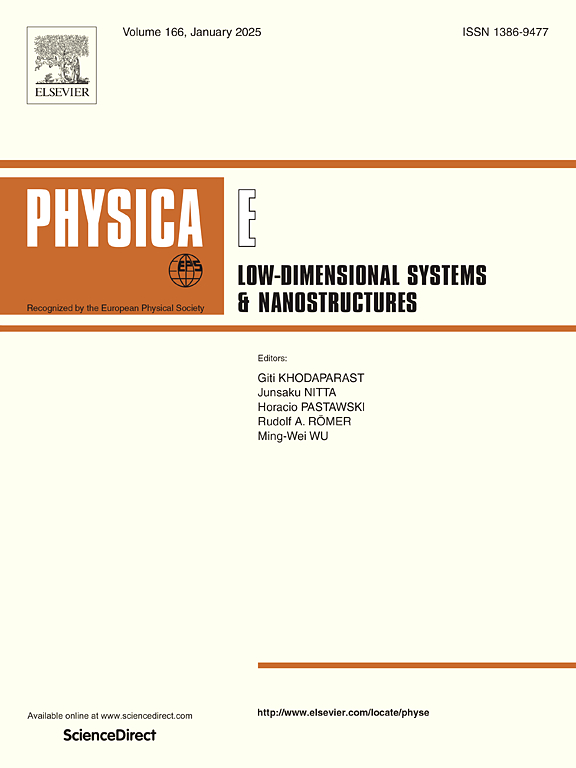Callaway散射模型下声子Boltzmann输运方程的不连续Galerkin有限元法
IF 2.9
3区 物理与天体物理
Q3 NANOSCIENCE & NANOTECHNOLOGY
Physica E-low-dimensional Systems & Nanostructures
Pub Date : 2025-05-14
DOI:10.1016/j.physe.2025.116295
引用次数: 0
摘要
声子玻尔兹曼输运方程(BTE)的时空依赖解对于研究有限尺寸微纳米器件中的热输运至关重要。本研究的重点是为解决不规则几何形状中的声子BTE而量身定制的数值框架的开发。具体地说,利用Callaway双松弛近似,建立了求解声子BTE的二维隐节点不连续Galerkin有限元方法。通过这种方法,研究了不同几何形状的石墨烯带中热输运的大小和波动效应。使用DGFEM进行的数值模拟与现有文献显示出值得赞扬的一致性,证实了该方法在模拟有限尺寸微结构中的声子输运方面的有效性和准确性。此外,DGFEM的应用有助于探索弯曲石墨烯带中的热输运。值得注意的是,在极窄的石墨烯带中,引入扭结导致热导率显著降低高达14.8%。此外,扭结的存在引起热导率随温度的明显单调上升。这些发现为通过扭结调制来操纵微观结构中的热输运提供了切实的指导。本文章由计算机程序翻译,如有差异,请以英文原文为准。
Discontinuous Galerkin finite element method for phonon Boltzmann transport equation under Callaway's scattering model
Spatially and temporally dependent solutions of phonon Boltzmann transport equation(BTE) are essential to investigate thermal transport in finite-size micro- and nano-scale devices. This study focuses on the development of a numerical framework tailored for addressing the phonon BTE within irregular geometries. Specifically, a two-dimensional implicit nodal discontinuous Galerkin finite element method (DGFEM) is developed for solving the phonon BTE with Callaway’s dual relaxation approximation. Through this methodology, the size and wave effects of thermal transport in graphene ribbons with varying geometries are investigated. Numerical simulations conducted using the proposed DGFEM exhibit commendable concordance with extant literature, affirming the method's efficacy and precision in modeling phonon transport within finite-size microstructures. Furthermore, the application of DGFEM facilitates an exploration of thermal transport in kinked graphene ribbons. Notably, in exceedingly narrow graphene ribbons, the introduction of kinks results in a significant reduction of thermal conductance by up to 14.8 %. Moreover, the presence of kinks elicits a discernible monotonic escalation of thermal conductance with temperature. These findings furnish tangible directives for manipulating thermal transport in microstructures via kink modulation.
求助全文
通过发布文献求助,成功后即可免费获取论文全文。
去求助
来源期刊
CiteScore
7.30
自引率
6.10%
发文量
356
审稿时长
65 days
期刊介绍:
Physica E: Low-dimensional systems and nanostructures contains papers and invited review articles on the fundamental and applied aspects of physics in low-dimensional electron systems, in semiconductor heterostructures, oxide interfaces, quantum wells and superlattices, quantum wires and dots, novel quantum states of matter such as topological insulators, and Weyl semimetals.
Both theoretical and experimental contributions are invited. Topics suitable for publication in this journal include spin related phenomena, optical and transport properties, many-body effects, integer and fractional quantum Hall effects, quantum spin Hall effect, single electron effects and devices, Majorana fermions, and other novel phenomena.
Keywords:
• topological insulators/superconductors, majorana fermions, Wyel semimetals;
• quantum and neuromorphic computing/quantum information physics and devices based on low dimensional systems;
• layered superconductivity, low dimensional systems with superconducting proximity effect;
• 2D materials such as transition metal dichalcogenides;
• oxide heterostructures including ZnO, SrTiO3 etc;
• carbon nanostructures (graphene, carbon nanotubes, diamond NV center, etc.)
• quantum wells and superlattices;
• quantum Hall effect, quantum spin Hall effect, quantum anomalous Hall effect;
• optical- and phonons-related phenomena;
• magnetic-semiconductor structures;
• charge/spin-, magnon-, skyrmion-, Cooper pair- and majorana fermion- transport and tunneling;
• ultra-fast nonlinear optical phenomena;
• novel devices and applications (such as high performance sensor, solar cell, etc);
• novel growth and fabrication techniques for nanostructures

 求助内容:
求助内容: 应助结果提醒方式:
应助结果提醒方式:


